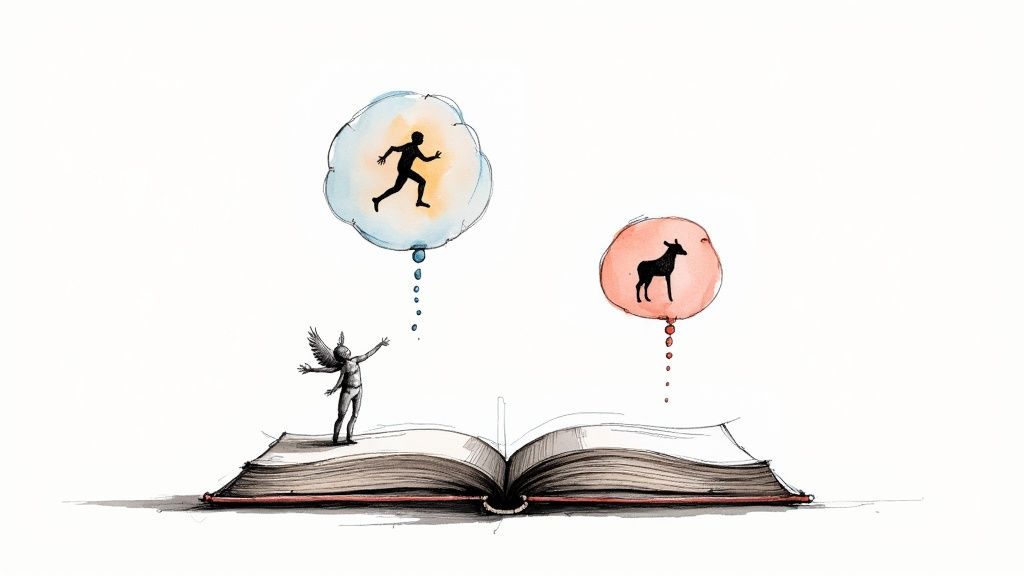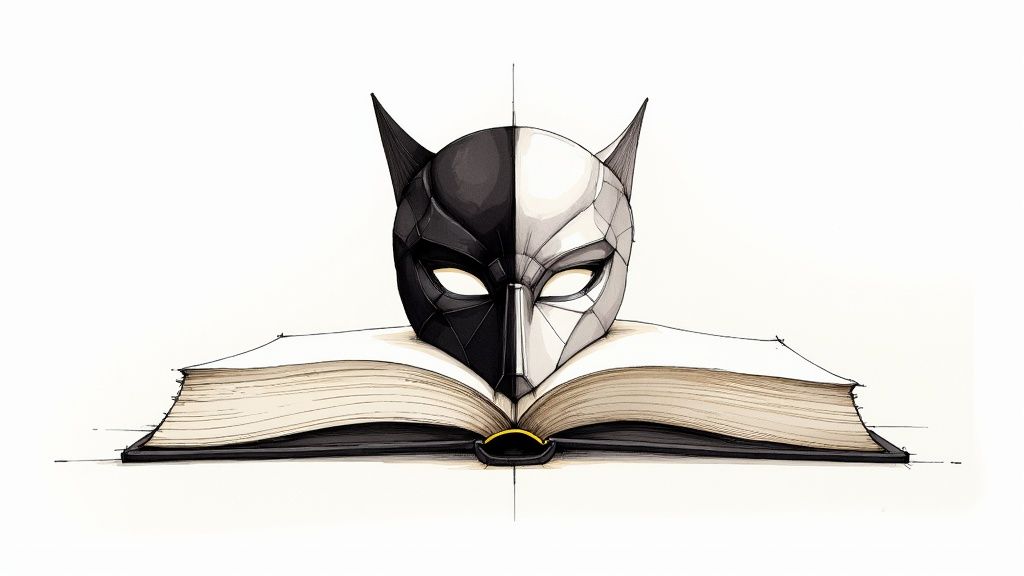The middle school years are a whirlwind of change, growth, and burgeoning creativity. It’s the perfect time to explore storytelling, but the dreaded blank page can be intimidating for even the most imaginative student. That’s where this guide comes in. We’ve curated a collection of dynamic and engaging creative writing prompts for middle schoolers, designed not just to provide a topic, but to build foundational skills in a way that feels like play, not homework.
These prompts move beyond simple story starters. From crafting superhero origin stories with an unexpected twist to retelling classic tales from a villain's point of view, each idea is tailored to capture the unique energy and curiosity of this age group. They are specific, actionable starting points that help develop key skills like empathy, critical thinking, and building a confident narrative voice. To further ignite imagination and foster creative thinking, consider exploring 10 Innovative Ways to Ignite Ideas for additional strategies that complement these exercises.
Our goal is to provide tools that help your young writer see their unique perspective as the most powerful storytelling tool they possess. Let’s dive into prompts that will transform the chore of 'I have to write' into the excitement of 'I can't wait to see what happens next'.
1. "What If" Scenario Writing
"What if" scenarios are among the most powerful creative writing prompts for middle schoolers because they start with a simple question that unlocks immense imaginative potential. This technique challenges students to take a familiar concept and twist it by changing one fundamental rule. The goal is to explore the ripple effects of that single change, creating a completely new world or situation from the ground up.

This prompt style excels at developing critical thinking alongside creativity. Students must logically consider the consequences of their alternate reality, which strengthens their world-building skills. For instance, a simple prompt like "What if humans didn't need to sleep?" forces a writer to think about how society, work, school, and even architecture would change in a 24/7 world.
Putting It Into Practice
To make this prompt effective, encourage students to focus on the details. Instead of just stating that the world is different, they should show it through a character's daily life.
-
Example Prompt: What if gravity worked in reverse, pushing things away from the Earth instead of pulling them in?
- Good Implementation: A story could follow a character getting ready for school, describing how they use weighted boots to stay on the ground and navigate a city where buildings are anchored deep into the earth.
-
Example Prompt: What if emotions were visible as colorful auras around people?
- Good Implementation: A narrative could explore a conflict where a character is trying to hide their fear (a shivering, gray aura) during a class presentation, making a common experience feel fresh and fantastical.
For students who feel stuck, having a solid foundation for their narrative is key. Getting the beginning right can set the stage for a compelling exploration of their "what if" world. If you want to dive deeper, you can find great tips on how to start writing a story on Number 6 Publishing's blog. This approach helps turn a simple question into a fully realized story.
2. Perspective Flip Stories
Perspective Flip Stories challenge students to retell a well-known story, fairy tale, or historical event from an entirely new point of view. This prompt encourages writers to step into the shoes of a villain, a minor character, or even an inanimate object, revealing that every character is the hero of their own narrative. It’s a powerful tool for developing empathy and understanding the complexities of motivation.

This style of creative writing prompt for middle schoolers pushes beyond simple retelling by demanding a deep dive into character psychology. Why did the "villain" make those choices? What did a background character see that the hero missed? Answering these questions helps students appreciate that perspective shapes reality, a concept popularized by works like Jon Scieszka's The True Story of the Three Little Pigs and Gregory Maguire's Wicked.
Putting It Into Practice
To make this prompt successful, encourage students to explore the "why" behind the new narrator's actions. Justifying their behavior with a compelling backstory is key to creating a believable and engaging narrative.
-
Example Prompt: Retell the story of Goldilocks from the perspective of Baby Bear.
- Good Implementation: The story could frame the event as a terrifying home invasion. It might focus on Baby Bear’s feelings of violation and fear upon finding his favorite chair broken and his bed occupied by a strange intruder.
-
Example Prompt: Describe the Boston Tea Party from the perspective of a crate of tea.
- Good Implementation: A humorous or tragic narrative could detail the crate’s long journey across the ocean, its excitement to arrive in a new land, and its ultimate despair as it's unceremoniously dumped into the cold, dark harbor by angry colonists.
Helping students build out these alternative viewpoints is crucial. One effective technique is using a Venn diagram to compare the original protagonist's motivations with the new narrator's. You can explore more strategies for character development and making stories memorable by reading up on how to write a good story, like the advice offered on Reedsy's blog.
3. Time Capsule Letters to Future Self
Writing a letter to a future self is one of the most personal and reflective creative writing prompts for middle schoolers. This activity encourages students to freeze a moment in time, capturing their current life, thoughts, and feelings. It bridges the gap between personal journaling and imaginative writing by asking them to envision who they will become and what their future world might look like.

This prompt is powerful because it carries real emotional weight. Unlike a purely fictional story, the author is the main character, and the audience is a future version of themselves. This built-in purpose motivates students to write with honesty and detail, fostering introspection and self-awareness. They document their present reality while making predictions and setting goals for the person they hope to be.
Putting It Into Practice
To make this exercise meaningful, provide students with guiding questions to help them capture a detailed snapshot of their lives. The goal is to create a rich document that will be fascinating to read years later.
-
Example Prompt: Write a letter to yourself on your high school graduation day. Describe your biggest worries about starting high school and what you hope you will have accomplished by then.
- Good Implementation: The student details their anxiety about making new friends and finding their classes, then lists specific goals like making the varsity soccer team and taking an art class.
-
Example Prompt: Write to your 25-year-old self. Describe the technology you use every day (your phone, favorite apps, video games) and ask your future self how much things have changed.
- Good Implementation: A letter could humorously describe current slang and fashion trends, making predictions about future technology and wondering if their favorite songs are now considered "oldies."
This prompt is an excellent opportunity for private, reflective writing. Consider giving students the option to seal their letters in envelopes, to be returned to them at the end of the school year or even at their 8th-grade graduation. This adds a sense of ceremony and genuine purpose to the task, transforming a simple assignment into a cherished keepsake.
4. Mystery Object Story Generator
The Mystery Object Story Generator is one of the most effective creative writing prompts for middle schoolers for its ability to anchor an entire narrative to a single, tangible item. Students are given an unusual, mysterious, or even an ordinary object and tasked with building a story around it. The prompt challenges them to imagine the object's history, its journey through different hands, or its hidden significance.

This technique is excellent for teaching object-focused narrative construction and showing students that every item, no matter how small, can hold a story. By focusing on an object, writers learn to develop plot, character, and setting through its connection to the world around it. A simple prompt like "Tell the story of this worn teddy bear" can lead to a multigenerational family saga or a tale of a lost toy's epic journey home.
Putting It Into Practice
To make this prompt successful, encourage students to use sensory details to describe the object before they start writing its story. A physical object, a photograph, or even a 'mystery box' filled with interesting trinkets can provide powerful inspiration.
-
Example Prompt: A mysterious, ornate key is found in an old school locker. What does it unlock?
- Good Implementation: The story could focus on the suspense of finding the key and the adventure of searching for its lock, which might not open a door but perhaps a hidden compartment in the library or a forgotten music box.
-
Example Prompt: An antique mirror shows different reflections to different people. Tell the story of three people who look into it.
- Good Implementation: A narrative could explore how the mirror reflects a person's true self, their greatest desire, or their deepest fear, creating a character-driven story linked by the single magical object.
This prompt helps students understand how to build suspense and intrigue from a central element. For those interested in exploring this genre further, you can find a curated list of great mystery books for young readers on Number 6 Publishing's blog. It’s a great way to show how a simple object can be the key to a captivating mystery.
5. Door to Anywhere Portal Stories
Portal stories are classic creative writing prompts for middle schoolers that tap into the timeless fantasy of discovery. This prompt invites students to imagine finding a hidden door, gateway, or passage that leads to an entirely different world, time period, or dimension. Popularized by tales like The Chronicles of Narnia and Alice in Wonderland, this setup provides a natural story structure by grounding the narrative in a familiar reality before plunging into the unknown.
The power of this prompt lies in its blend of the ordinary and the extraordinary. It encourages students to build a new world from scratch while also considering how a character from our world would react to it. This contrast between the two settings creates immediate intrigue and conflict, giving students a clear framework for exploring themes of courage, adaptation, and discovery. The journey through the portal becomes a journey of self-discovery.
Putting It Into Practice
To make a portal story compelling, encourage students to establish clear rules for their new world and the portal itself. The discovery of the portal should be a captivating moment that hooks the reader from the start.
-
Example Prompt: A forgotten locker in the school gym opens into a dimension where sports are fought as real gladiator-style battles.
- Good Implementation: The story could focus on an unathletic student who accidentally stumbles through and must use their wits, not brawn, to survive the bizarre and dangerous competitions.
-
Example Prompt: A hollow tree in the backyard is a portal that leads to a different historical period each time it’s entered.
- Good Implementation: A narrative could follow two siblings who travel back to ancient Rome one day and the Wild West the next, trying to solve a historical mystery without changing the past.
Defining the rules of the portal (How does it open? Can you bring things back?) gives the story structure and stakes. For writers looking to add depth to their characters' journeys, the article on crafting a compelling character arc on the Now Novel blog offers excellent guidance. This helps ensure the character's experience in the new world leads to meaningful personal growth.
6. Dialogue-Only Story Challenge
The dialogue-only story is one of the most effective creative writing prompts for middle schoolers to sharpen their ear for voice and subtext. This constraint-based challenge requires students to write an entire scene or story using only dialogue. There is no narration, no description, and no action tags like "he said" or "she whispered." All plot, emotion, and setting must be revealed through what the characters say to each other.
This prompt forces students to master the art of "showing, not telling" in a unique way. Instead of describing a character's anger, they must write dialogue that sounds angry. This exercise is invaluable for developing an understanding of character voice, pacing, and conflict. By removing the safety net of narration, writers learn to make every word a character speaks count.
Putting It Into Practice
To get started, encourage students to keep the character count low, ideally just two or three, to maintain clarity. Reading short plays or film scripts can provide excellent models for how dialogue carries a story.
-
Example Prompt: Write a dialogue-only scene where two siblings argue about a broken family heirloom, revealing a much bigger secret in the process.
- Good Implementation: The conversation could start with accusations about the object but slowly shift as one character says something like, "You're not mad about the vase. You're mad because you found out what Mom told me."
-
Example Prompt: Write a phone conversation where one person is trying to subtly signal that they are in danger without the person on the other end (or the captor) realizing it.
- Good Implementation: The dialogue would be filled with subtext, using seemingly normal phrases as code words, with the character's growing panic conveyed through short, clipped responses or a sudden change in topic.
This challenge is a fantastic way to break out of a writing rut. For a complete guide and more examples, explore our full breakdown of the Dialogue-Only Story Challenge on the Number 6 Publishing blog. This approach helps students develop skills that will improve every aspect of their narrative writing.
7. Superhero Origin Story with a Twist
Superhero narratives are incredibly popular, but this prompt asks students to move beyond simple hero-versus-villain tales. By creating a superhero origin story with a specific twist, they can explore character depth, subvert expectations, and think critically about the genre. This prompt leverages students’ familiarity with superheroes while encouraging originality and a deeper look at what makes a character compelling.
The "twist" is the key element that makes this one of the most effective creative writing prompts for middle schoolers. It forces them to avoid clichés and consider the real-world implications of having powers. For instance, a hero whose power is actually a major inconvenience or stems from a mundane source creates instant conflict and personality. This approach, seen in works like Marissa Meyer's Renegades series, focuses on the humanity behind the superpowers.
Putting It Into Practice
Encourage students to brainstorm the character's personality and problems before deciding on their powers. The twist should feel connected to who the character is, not just a random gimmick.
-
Example Prompt: Write an origin story for a hero whose powers come from their grandmother's secret cookie recipe.
- Good Implementation: A story could focus on the hero trying to protect the recipe from a corporate spy while also figuring out why eating a snickerdoodle suddenly gives them super speed for ten minutes. The stakes are both personal and heroic.
-
Example Prompt: Create a villain's origin story that makes the reader sympathize with them.
- Good Implementation: The narrative could show how a character with the power to control plants was ostracized and eventually turned to villainy after developers destroyed the last local park they called home, blurring the line between good and evil.
This prompt is excellent for developing complex characters. By adding limitations and unconventional origins, students learn that a character's flaws and struggles are often more interesting than their strengths.
8. Five Senses Immersion Scene
One of the most effective creative writing prompts for middle schoolers is the Five Senses Immersion Scene, a technique that prioritizes atmosphere and vivid imagery over plot. This prompt challenges students to describe a specific setting or moment by incorporating details related to sight, sound, smell, taste, and touch. The goal is to transport the reader directly into the scene, making them feel as if they are experiencing it firsthand.
This method is crucial for teaching the "show, don't tell" principle. Instead of telling the reader that a character is nervous, a student can show it through the metallic taste of fear in their mouth or the feeling of clammy palms. By focusing on sensory input, young writers learn to build a strong sense of place and mood, which serves as a powerful foundation for any narrative.
Putting It Into Practice
To use this prompt, ask students to choose a location rich with sensory potential. Encourage them to brainstorm details for each of the five senses before they start writing.
-
Example Prompt: Describe walking through a busy farmers market on a Saturday morning.
- Good Implementation: The story could detail the sight of brightly colored pyramids of fruit, the sound of a distant musician and overlapping chatter, the smell of fresh kettle corn mixed with damp earth, the taste of a sweet strawberry sample, and the feel of bumping into a stranger’s rough canvas bag.
-
Example Prompt: Write about the moments in a library during a powerful thunderstorm.
- Good Implementation: A writer could focus on the muffled sound of thunder outside, the crisp, papery smell of old books, the sight of rain streaking down the tall windows, and the feeling of the cool, smooth surface of a wooden table beneath their fingertips.
This approach helps students slow down and observe the world more carefully, both in their writing and their daily lives. For those looking to see how professional authors master this skill, the Book Trust offers examples of descriptive writing that can serve as excellent mentor texts. This exercise turns a simple scene into a memorable, immersive experience.
Creative Writing Prompts Comparison Guide
| Prompt Title | Implementation Complexity 🔄 | Resource Requirements ⚡ | Expected Outcomes 📊 | Ideal Use Cases 💡 | Key Advantages ⭐ |
|---|---|---|---|---|---|
| "What If" Scenario Writing | Moderate - scaffold may be needed | Low - mostly imagination & writing | Develops critical thinking, creativity | Exploration of alternative realities | Builds divergent thinking and cause-effect |
| Perspective Flip Stories | Low to Moderate - familiarity needed | Low - uses existing stories | Teaches empathy, multiple perspectives | Retelling known stories from different views | Enhances character voice & social-emotional |
| Time Capsule Letters to Future Self | Low - guided prompts recommended | Low - personal reflection | Builds self-reflection, goal setting | Reflective writing with authentic purpose | Engages personal experience & metacognition |
| Mystery Object Story Generator | Moderate - requires object access | Medium - physical or visual objects | Develops sensory description, narrative | Stories based on objects' histories | Tangible inspiration and observation skills |
| Door to Anywhere Portal Stories | Moderate - world-building involved | Low to Medium - imagination focused | Builds world-building and narrative arc | Fantasy stories with clear structure | Combines realism with fantasy; clear plot |
| Dialogue-Only Story Challenge | High - requires strict constraints | Low - focus on dialogue only | Develops dialogue, subtext, character voice | Dialogue practice, reluctant writers | Encourages creativity via constraints |
| Superhero Origin Story with a Twist | Moderate - genre knowledge helpful | Low - creative writing | Builds character, genre subversion | Pop culture and originality in superhero tales | High engagement, genre awareness |
| Five Senses Immersion Scene | Low to Moderate - sensory focus | Low - observation and writing | Improves descriptive writing and atmosphere | Sensory detail practice across genres | Teaches "show, don't tell"; vivid imagery |
Keeping the Creative Momentum Going
The journey through these creative writing prompts for middle schoolers has hopefully sparked a universe of ideas. We’ve explored everything from "What If" scenarios that twist reality and perspective flips that build empathy, to dialogue-only challenges that sharpen storytelling skills. The goal was never just to provide a list, but to hand over a set of keys capable of unlocking the vast, imaginative worlds that reside within every young writer. Each prompt, whether it’s designing a superhero with a unique flaw or describing a scene using only the five senses, is a tool for building confidence, honing craft, and discovering the sheer joy of creation.
The true value of these exercises lies not in a single, perfectly crafted story, but in the habit of creative exploration. Consistent practice is what transforms a spark of interest into a lifelong passion. The prompts in this article are starting points, designed to be flexible and adaptable. Encourage your middle schooler to treat them like building blocks, combining ideas, twisting concepts, and even creating their own prompts from scratch. The "Mystery Object" prompt, for example, could be combined with the "Door to Anywhere" concept to create a story about an ordinary object that is actually the key to a magical portal.
Actionable Next Steps for Young Writers
To transform these prompts into a sustainable writing habit, consider these practical steps:
- Establish a "Writer's Notebook": Designate a specific journal or digital document exclusively for creative writing. This creates a dedicated, low-pressure space for brainstorming, drafting, and experimenting without the fear of grades or judgment. To maintain a consistent writing practice and nurture their creative thoughts, you might find valuable insights in articles discussing journaling to nurture the mind.
- Create a Prompt Jar: Write individual prompts from this list (and others you invent) on small slips of paper and place them in a jar. When inspiration is low, the student can simply pull one out for an instant creative challenge. This gamifies the process and removes the paralysis of choosing what to write about.
- Share and Celebrate: Create opportunities for your young writer to share their work, but only if they are comfortable doing so. This could be reading a short story aloud to the family, starting a writing club with friends, or submitting a piece to a school literary magazine. Positive reinforcement is a powerful motivator.
Ultimately, providing engaging creative writing prompts for middle schoolers is about more than just improving their language arts skills. It’s about empowering them to see the world differently, to ask critical questions, and to understand that their voice matters. By nurturing this creative spirit, you are giving them an invaluable tool for self-expression, problem-solving, and connection that will serve them far beyond the classroom. The most incredible stories are waiting to be told; now, it's time to hand them a pen and watch the magic unfold.
Looking for stories that ignite the same spark of imagination these prompts are designed to foster? At Number 6 Publishing, we specialize in crafting captivating middle-grade and young adult fiction that encourages curiosity and celebrates unique voices. Explore our collection of books to find your young writer's next great adventure at Number 6 Publishing.
